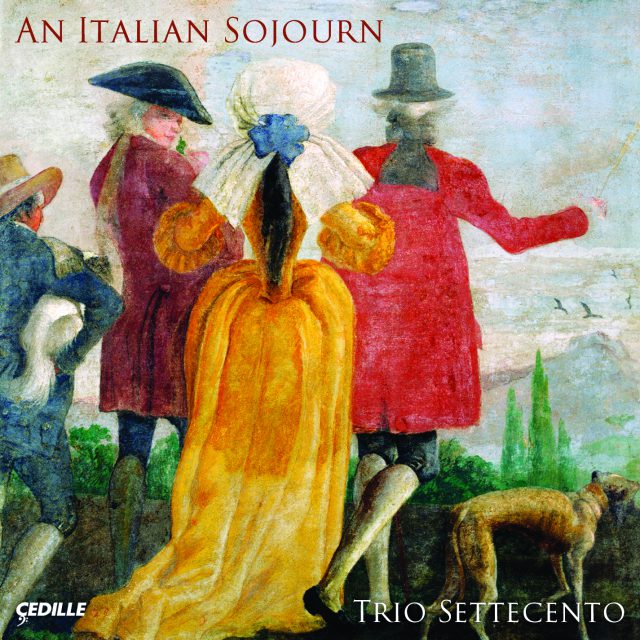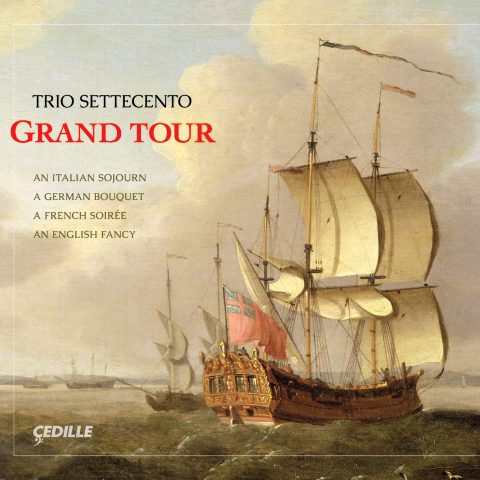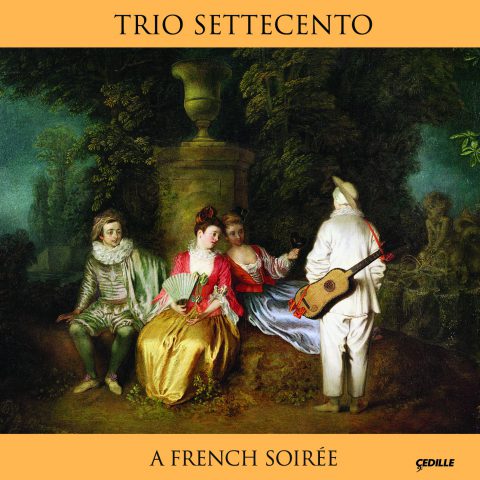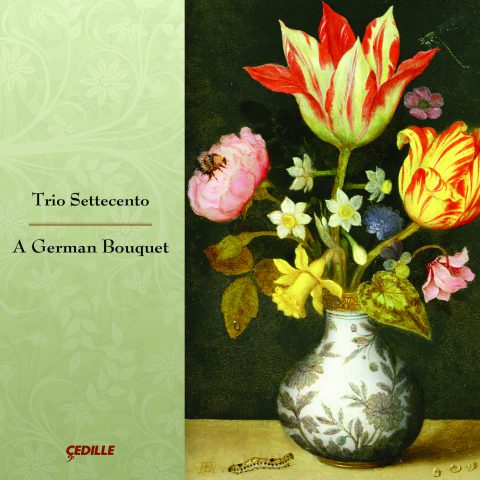| Subtotal | $18.00 |
|---|---|
| Tax | $1.85 |
| Total | $19.85 |
Store

Trio Settecento brings fresh insights to music from the Age of Enlightenment through its passionate, authoritative, and distinctive interpretations.
The period instrument ensemble’s new CD, An Italian Sojourn, traces the remarkable musical innovations of composers in Venice, Rome, and beyond during the Baroque era through works by eight different composers including Marini, Corelli, Veracini, Tartini, and Locatelli.
In the hands of Trio Settecento (The 1700s Trio), these masterpieces exude the dramatic intensity of the Italian school.
Reviewing the trio’s 2006 New York debut, The New York Times declared, Pine “played remarkably. . . . Mr. Rozendaal and Mr. Schrader contributed a rich, modestly varied texture.”
Preview Excerpts
DARIO CASTELLO (FL. 1621–1636)
ALESSANDRO STRADELLA (1644–1682)
BIAGIO MARINI (1678–1741)
PIETRO ANTONIO LOCATELLI (1695–1764)
Sonata da camera, Op. 6, No. 2 in F Major
ARCANGELO CORELLI (1653–1713)
Sonata in C Major, Op. 5, No. 3
GIUSEPPE TARTINI (1692–1770)
Sonata Pastorale in A Major
GEORGE FRIDERIC HANDEL (1685–1756)
Sonata in G minor, HWV 364a
FRANCESCO VERACINI (1690–1750)
Sonata in D minor, Op. 2, No. 12
Artists
Program Notes
Download Album BookletA Personal Note
Notes by Rachel Barton Pine
What a difference a decade makes! In 1996, John Mark Rozendaal, David Schrader, and I collaborated on a recording of Handel’s Violin Sonatas. We enjoyed working together so much that in 1997, we formed Trio Settecento. This album, An Italian Sojourn, represents the culmination of ten years’ growth for us as individuals and as an ensemble.
In 1996, I recorded Handel using a modernized 1617 Amati and a baroque bow. My interpretations on that album combined a historically-informed approach to phrasing and ornamentation with a contemporary application of vibrato. This continues to be my approach when performing a Baroque sonata alongside Romantic and 20th/21st Century works on my 1742 Guarneri del Gesu.
However, my exploration of the sound world of the 17th and 18th Centuries has evolved significantly. In 2002, I began performing this music on a 1770 Nicola Gagliano in original condition. This beautiful instrument has had a remarkable effect on my capability to be faithful to the early composers’ intents and to bring their music most fully to life.
I am so grateful for the opportunity to collaborate with John Mark and David. Their passion for music, boundless thirst for knowledge, and mastery of their instruments makes our time together an exciting musical adventure and increasingly rewarding. The longer we play together, the more we breathe as one, anticipate each others’ nuances, and discover increased freedom and spontaneity in our improvisations. And through all these years of intense rehearsing, we remain the best of friends!
Baroque music holds the power to delight and astonish. We chose the pieces on this album for their profound beauty and sometimes startling originality, even eccentricity. I hope that you are as excited to discover this music as we always are to play it.
An Italian Sojourn
Notes by John Mark Rozendaal
Historians in the fields of the sciences, social and political studies, psychology, philosophy, religion, literature, and the arts all note an important shift in some core aspect of social and human consciousness — indeed in the basic ways of human beings — in Europe dating from about 1600. From this moment, Westerners began to adopt a new, more complex attitude towards the “self,” fundamentally redefining personhood. In the field of music, the new paradigm was signaled by the development of an entirely new voice. This new voice of the seventeenth century included a new technique of vocal production; an analogous new “voice” for instruments (the voice having long been regarded as a type of instrument, and instruments as stand-ins for voices); a powerful new persona for the individual performer; and a cultural phenomenon encompassing a new concept of “audience,” including new institutions through which audiences and performers could meet one another. The birthplace of the new voice was, of course, in the land of music, Italy; the conception occurred quietly in Florence and then vociferously in Venice. While the first embodiment of the new voice was the opera singer, the violinist was a not-too-distant second. In Trio Settecento’s “Italian Sojourn” program we follow the voice of the Cremona violin to hear what that voice could say: what tales of mystery, joy, or tragedy it could tell in Venice and Rome, and even as an expat in Dresden or Amsterdam.
We first learn of the poetic story-telling violinist in Venice. There is a likely reason that the art of the wordless voice made its early appearance in this location. Historians of Baroque music point to the spatial and temporal patterning of the concerto (both sacred with voices and instrumental) as Venice’s special contribution to the evolution of 17th-century music. Given Venice’s close cultural ties with the East and the pride with which Venetian nobles and institutions acquired Islamic art, one wonders whether the virtuosic refinement of abstract decoration found in Turkish, Arab, and Persian design played a role in shaping European instrumental music. In a Persian carpet or Turkish tile decoration one finds abstract motifs repeated, varied, developed, and placed in a coherent structure with a beginning, middle, and end; and main themes developed by repetition, fragmentation, and variation, and punctuated by episodes. Does this not describe precisely the concerto format through which J.S. Bach claimed to have learned “musical thinking” from the compositions of Vivaldi? This particularly Venetian musical pattern thinking is the technique that Biagio Marini and Dario Castello develop and deploy to structure the rhetoric of the newly vocalized violin. To hear these pieces in their richest context we may imagine them performed in the opulence of the Basilica of San Marco or a palazzo on the Grand Canal, replete with ornate window traceries, vessels of damascene and draperies of damask from Damascus, gilded icons from Byzantium, gleaming glass objects from Egypt, and, of course, carpets from Persia and Turkey.
The next stop on our Italian sojourn is Rome, whither Allessandro Stradella, Arcangelo Corelli, and the the youthful Georg Friedrich Handel all traveled to enjoy the unique possibilities for inspiration and prestigious patronage available only in the Eternal City. Alessandro Stradella’s work in Rome was supported by that notorious legend-in-her-own-time, Queen Christina of Sweden, bringing him to the center of Catholic Europe’s most exclusive set of beautiful people. Stradella’s short and scandalous life would provide enough interesting material to fill this essay. Here it will suffice to note that, like Mozart and Purcell, this prodigy produced in fewer than four decades hundreds of works in all musical genres whose poetic beauty caused him to be remembered with romantic regret for generations after his untimely demise. The Sinfonia on our program is a rich amalgam of quasi improvisatory passages, carefully worked counterpoint, and dance elements.
To assess the achievement of Arcangelo Corelli, we can do no better than to quote the great English connoisseur Charles Burney, whose judgment, recounted in his General History of Music (1789), remains insightful today:
“We are now arrived at a memorable era for the violin, tenor [viola], and violoncello; when the works and performance of the admirable Arcangelo Corelli (1653–1713), rendered them respectable, and fixed their use and reputation, in all probability, as long as the present system of Music shall continue to delight the ears of mankind. Indeed, this most excellent master had the happiness of enjoying part of his fame during his mortality; for scarce a contemporary musical writer, historian, or poet neglected to celebrate his genius and talents; and his productions have contributed longer to charm the lovers of Music by mere powers of the bow, without the assistance of the human voice, than those of any composer that has yet existed. Haydn, indeed, with more varied abilities, and a much more creative genius, when instruments of all kinds are better understood, has captured the musical world in, perhaps, a still higher degree; but whether the duration of his favour will be equal to that of Corelli, who reigned supreme in all concerts, and excited undiminished rapture full half a century, must be left to the determination of time, and the encreased rage of depraved appetites for novelty.”
Of Corelli’s Opus V, Burney wrote:
“Corelli’s Solos, as a classical book for forming the hand of a young practitioner on the violin, has ever been regarded as a most useful and valuable work, by the greatest masters of the instrument. I was told by Mr. Wiseman at Rome, that when he first arrived in the city, about twenty years after Corelli’s decease, he was informed by several persons who had been acquainted with him that his opera quinta, on which all good schools for the violin have been founded, cost him three years to revise and correct. Tartini formed all his scholars on these solos; and Signor Giardini has told me, that of any two pupils of equal age and disposition, if one was to begin his studies by Corelli, and the other by Geminiani, or any other eminent master whatever, he is sure that the first would become the best performer.”
Burney’s recognition of Corelli’s importance as a pedagogical resource and model is no less true today, more than two centuries later, as evidenced by the musical inheritance that Rachel Barton Pine shares with many of today’s finest violinists: Ms. Pine studied with Almita Vamos whose violinistic lineage can be traced back in an unbroken thread through Louis Persinger, Eugene Ysaye, Henri Vieuxtemps, Charles DeBeriot, G. B. Viotti, Gaetano Pugnani, and G. B. Somis to Corelli himself.
In 1706, the Academy of the Arcadians, the famous Roman group of musicians, poets, and prelates, relaxed its usual rules for membership to admit a young foreigner of uncommon talent. G.F. Handel was nick-named “Il Sassone” (the Saxon) by the Romans who enjoyed the exquisite early cantatas and oratorios of the man who would become the most celebrated composer of the era. Corelli collaborated with Handel in important projects including the oratorio “Il Resurrezione.” Corelli’s model for the sonata and for the voice of the violin is clearly the template and inspiration for Handel’s violin sonatas.
Eighteenth-century virtuosi expanded and embellished Corelli’s violinistic language to an incredible extent, thrilling their audiences with hair-raising difficulties: complex multiple-stopping, high notes and higher notes, special bowing techniques requiring agility and years of practice, and ornaments and divisions of staggering complexity. Franceso Veracini, Giuseppe Tartini, and Pietro Locatelli all participated in this trend. Yet for all of the impressive instrumental gymnastics these perfomer/composers created, their sonatas are not mere flash. On the contrary, these were musicians of substance with considerable compositional technique and intellectual ambition. Veracini’s interests included serious exploration of alchemy, still a significant line of inquiry in the eighteenth century. Tartini is remembered in the history of musical theory for his writings relating harmony to geometry and arithmetic. Pietro Locatelli spent the better part of his career in residence in Amsterdam, directing an ensemble of amateur instrumentalists (excluding those whose motives might be clouded by professional ambition) and amassing an extensive library whose inventory attests to his interest in history, theology, philosophy, topography, and ornithology. Veracini, Locatelli, and Tartini hold in common a cosmopolitan international posture; all were active in carrying the music of the Italian violin into northern Europe, and each shows the influence of German and French music in his compositions.
Veracini’s Sonata in D-minor offers the twin thrills of a passacaglia and a chaconne. These genres both originated in the vaguely Spanish/Italian repertoires of dance music for the vihuela (early guitar) and, after effective appearances on the Italian operatic stage, developed into works of remarkable formal and emotional complexity in the ballets and operas of Lully. The two forms are extremely similar on paper: Both are triple-time dances, through-composed, based on repeating harmonic progressions, with special emphasis on the second beat of the bar. But in their theatrical context they have quite distinct characters and functions that Veracini clearly recalls. The passacaglia is the lament in which the operatic heroine pines for her lost love. The chaconne is the party piece in which all of the courtiers, nymphs, and shepherds celebrate the happy union of the lovers. Appearing in baroque chamber music works, these large dance movements are always suggestive of the theatrical. Veracini evokes a remarkable personal drama, opening the sonata with a powerfully tragic lament, detouring for a complex and peculiar fugue with two subjects, continuing with an incredibly developed ecstatic dance, and finishing with a cruel surprise return to the anguished passacaglia.
Locatelli’s Opus VII violin sonatas eschew the traditional slow-fast-slow-fast format in favor of a more modern arrangement in which a single slow-fast pair of movements is followed by an air with variations, often (as here) a minuet.
Tartini’s music shows the clear influence of the Prussian empfindsamer stil (expressive style). He may have learned this style from “Padre Boemo” (a.k.a. Bohuslav Cernuhorsky), with whom he studied at a monastic retreat in Assisi while hiding from the wrath of the Bishop of Padua. (Tartini had married without revealing that, by virtue of his monastic education, he was a candidate for the priesthood.)
Tartini’s Sonata Pastorale is a splendid example of a large sub-genre in baroque string music in which drone effects are used to evoke the traditional bagpipe music of shepherds. The conceit is associated with both the pastoral idiom in classical and renaissance poetry, and with the band of shepherds who were the first to pay their respects to the infant Jesus. (Corelli’s Christmas Concerto and the Pastoral Symphony section of Handel’s Messiah are two of the most famous of Examples.) In the eighteenth century, it is likely that even urban dwellers regularly heard the sounds of farm animals and the voices, songs, and dances of the people who tended them. (At this time the Roman forum was still referred to as the Campo vaccino because of the cows pastured there.) Thus, these pieces may well have been inspired by actual folk music of the time. The final movement of Tartini’s sonata treats this convention with exceptional vigor and variety, depicting the shepherds alternately dancing for joy and becalmed in rustic tranquility.
Album Details
Total Time: 70:51
Producer: James Ginsburg
Engineer: Bill Maylone
Graphic Design: Melanie Germond
Cover Painting: The Walk, c.1791 (oil on canvas) by Giandomenico (Giovanni Domenico) Tiepolo (1727-1804). Ca’o Rezzonico, Museo del Settecento, Venice, Alinari. © The Bridgeman Art Library International
Recorded: December 18, 19 , 21 & 22, 2006 in Nichols Concert Hall at the Music Institute of Chicago in Evanston, IL
Instrument Credits:
Violin: Nicola Gagliano, 1770, in original, unaltered condition
Violin Strings: Damian Dlugolecki
Violin Bows: Harry Grabenstein, replica of early 17th Century model (Castello, Stradella, Marini) / Louis Begin, replica of 18th Century model (Locatelli, Corelli, Tartini, Handel, Veracini)
Cello: Unknown Tyrolean maker, 18th century
Cello Bows: Louis Begin (Castello, Marini, Stradella) / Julian Clarke (Corelli, Handel, Locatelli, Tartini, Veracini)
Harpsichord: Willard Martin, Bethlehem, Pennsylvania, 1997. Single-manual instrument after a concept by Marin Mersenne (1617), strung throughout in brass wire with a range of GG-d3
Tuning: Unequal temperament by David Schrader, based on Werckmeister III
©2007 Cedille Records/Cedille Chicago
CDR 90000 099



